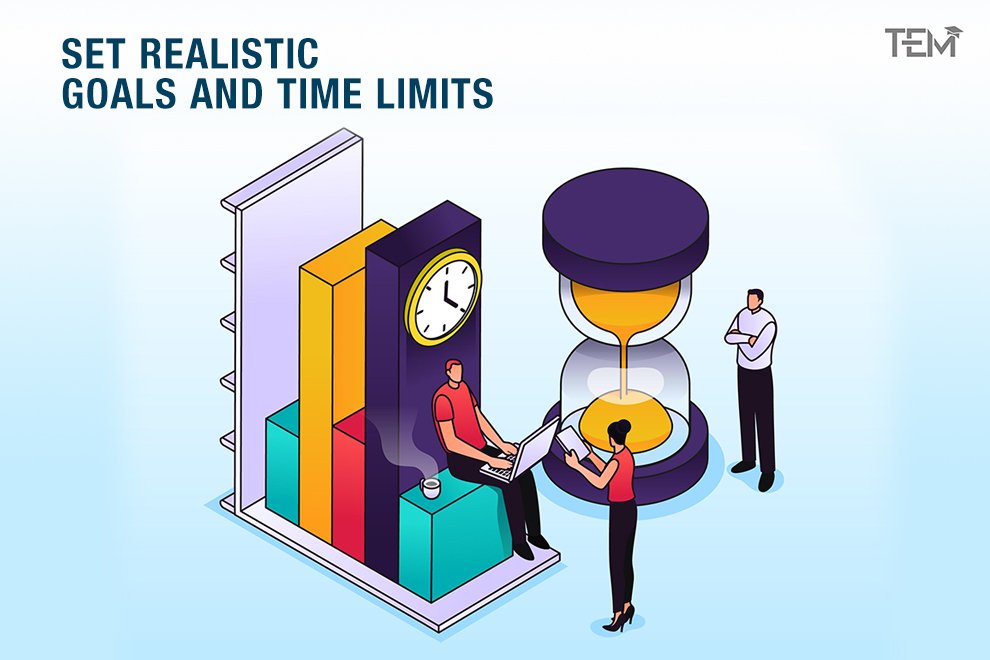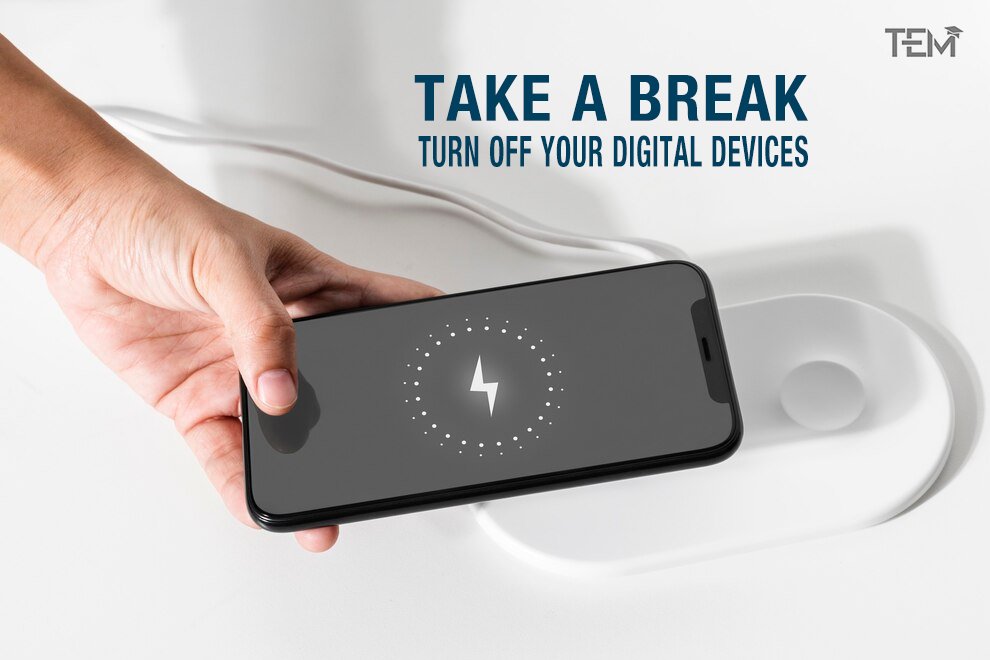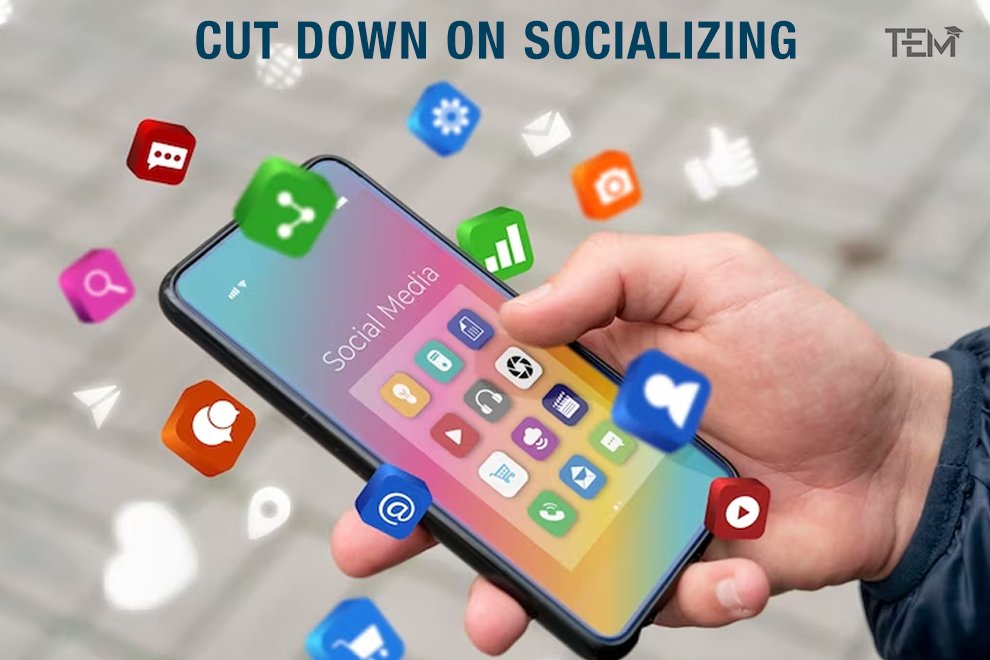According to a study, 49.8% of the world’s population will need glasses by 2050.
Another study found that the average person spends 6 hours and 58 minutes on screens per day.
Moreover, our attention spans have shrunk to a mere 47 seconds in 2023, down from 2.5 minutes in 2004.
This rapid decline, linked to technology and multitasking, raises a question: Does our constant switching hurt our productivity and creativity?
One of the main reasons for this alarming trend is the excessive use of screens in our daily lives.
We spend hours staring at our devices, whether for work, entertainment, or communication, often neglecting our eye health and overall well-being.
If you want to avoid this fate and enjoy a better quality of life, you need to reduce screen time.
In this article, I will share 10 easy and effective ways to reduce screen time without compromising your productivity or happiness.
You will learn how to set healthy boundaries, find alternative activities, and make the most of your time offline.
Here Are The 10 Effective Ways To Reduce Screen Time
1. Track Your Screen Time
Do you feel glued to your phone? Do you wonder where the hours vanish? Track your screen time!
Awareness is the first step in reducing screen time and reclaiming control. Here are some ways to track your screen time:
- Built-in Detectives
Most smartphones and computers offer built-in tools that reveal your daily and weekly usage, highlighting the top apps and categories.
This trick is very useful for parents who wish to control their children’s screen time.
According to the PEW Research Center, most parents of a child aged 5 to 11 (86%) restrict their child’s screen time, and 80% use screen-related punishments.
Three-fourths of these parents also monitor their child’s online activities (75%) and limit their screen usage with parental controls (72%).
- App Detectives
If your parents cannot control you, technology itself can. How? By apps. You can explore apps like RescueTime, Moment, or QualityTime.
These apps offer detailed breakdowns of your activity, including website and app usage, even across devices. Some even block distracting apps during set times.
Personally, these apps have been very helpful to me. I used to struggle a lot with screen time control.
But as soon as I switched to these apps, they made a big difference.
- Analog Solutions
Grab a notebook and jot down when you pick up your phone and for how long.
This low-tech method requires discipline but offers a personalized view of your habits, highlighting specific triggers.
This could be a very useful tip for teenagers, who often struggle with controlling what and how much they watch.
Do you struggle with excessive screen time? If so, you are not alone. Many people find it hard to balance their digital and offline lives. Setting unrealistic goals can leave you feeling frustrated and defeated.
Fortunately, there are practical methods for setting achievable limits that empower you to reduce screen time without stress. Here are some tips to help you get started.
2. Set Realistic Goals and Time Limits

Setting unrealistic goals can leave you feeling frustrated and defeated. Let’s dive into practical methods for setting achievable limits that empower you to reduce screen time without stress.
- Start Small, Dream Big
Begin by identifying your current screen time habits. How much time do you spend on your phone, computer, or TV every day? Track it for a few days using apps or built-in tools. You might be surprised by the results.
Then, set a realistic and specific goal to reduce screen time by just 10-15% in the first week. For example, if you spend 4 hours on screens per day, aim to cut it down to 3.5 hours or less. Celebrate small wins and gradually increase your goal as you progress.
Importantly, adults should limit their screen time to 2 hours or less outside of work. Adults tend to look at screens outside work thinking that it will relax them mentally, but it often does the opposite. It exhausts them more and more. Thus, adults can start by limiting their screen time outside work to 20 minutes at first and then gradually reduce it further.
- Prioritize Ruthlessly
Identify activities that truly enrich your life. Think about whether your screen time makes you happy or tired. Do you enjoy watching your favorite show or scrolling through social media? Or do you feel bored, anxious, or guilty afterward? You must prioritize activities that nourish your mind and body.
For instance, you can replace some of your screen time with hobbies, exercise, reading, or spending time with friends and family. These activities can boost your mood, creativity, and well-being.
Did you know that excessive screen time can harm your health? According to Nakshine et al, a research group, “Dependency on digital devices resulting in ever-increasing daily screen time has subsequently also been the cause of several adverse effects on physical, mental, or psychological health. Constant exposure to devices like smartphones, personal computers, and television can severely affect mental health—increase stress and anxiety, for example—and cause various sleep issues in both children and adults.”
- Harness Technology’s Power
You can also use technology to your advantage. Leverage built-in features like “Screen Time” to set automatic limits, reminders, and downtime. Moreover, explore apps that block distracting websites or track your progress, empowering you to reduce screen time effortlessly.
3. Create Tech-Free Zones
Dedicate spaces in your home or life where screens take a backseat, boosting your well-being and reducing screen time. Let’s explore effective methods to carve out these digital sanctuaries.
- Start Small
You can start by setting designated times, such as mealtimes or family gatherings, when everyone puts away their phones. This helps you connect with others and be mindful of your interactions. It’s a simple but powerful way to reduce screen time.
Did you know? According to an article by Gomedii, looking at your mobile while eating can cause the following problems:
- Overeating and obesity
- Distraction
- Unhealthy eating habits
- Lower metabolism
- Don’t Use Screens in Your Bedroom
Another tip is to banish screens from your bedroom. The blue light from screens disrupts your sleep cycle and affects your mood. Make your bedroom a tech-free zone for restful slumber and a calmer start to your day. This simple change can greatly enhance your sleep quality.
- Nature’s Embrace
Why not take your tech-free zone outdoors? Enjoy a walk, hike, or picnic without digital distractions. Immerse yourself in nature’s serenity and boost your mental health. This is one of the best ways to reduce screen time. Moreover, embracing nature can offer you a refreshing break from constant screen exposure.
- Power Down the “Perfect Place”
Choose a comfortable spot, like a reading nook or meditation corner. Declutter the area, add cozy blankets or plants and let it beckon you for screen-free relaxation. By creating this inviting space, you’ll naturally be drawn to spend more time away from screens.
- Get Creative
Finally, designate a craft room, art studio, or music corner. Engage in unplugged activities that spark your creativity and reduce your stress. Let your imagination soar, free from digital distractions. This shift to creative pursuits not only reduces screen time but also enriches your life in meaningful ways.
4. Embrace Do Not Disturb

Do you want to reduce your screen time and reclaim your focus? If so, the Do Not Disturb mode can be your secret weapon. This powerful tool helps you curb distractions and concentrate on what matters. Here is how it works.
- Quieting the Chorus
The Do Not Disturb mode silences notifications, calls, and texts. As a result, you eliminate the constant digital buzz that tempts you to check your phone. You can reduce your screen time instantly and avoid interruptions during tasks or deep work sessions.
- Visibility Matters
You can choose what gets muted on many devices. You can silence all notifications or customize them by app. This way, you can allow essential updates (like work emails) while blocking distracting social media alerts. You can promote focused attention and filter out the noise.
- Schedules for Serenity
You can set Do Not Disturb schedules to activate automatically during specific times, like evenings or work hours. This creates predictable tech-free periods that foster healthy habits. You can reduce your screen time effortlessly and enjoy more peace of mind.
- Sleep Soundly and Think Sharply
You can use Do Not Disturb for a good night’s sleep. Blue light from screens disrupts sleep cycles, which hinders focus and mood. By silencing your phone, you promote restful sleep and protect your eyes. You can think more sharply and increase your productivity the next day.
This tip is very important because many adults stay awake until late to see their phones. According to the NIH, blue light from screens can penetrate the lens and cause retinal photochemical damage.
- Personalize Your Peace
You can explore advanced settings like “focus mode” on the iPhone or custom profiles on Android. These settings allow you to tailor Do Not Disturb based on your needs. You can create tech-free zones for specific activities and reduce your screen time in targeted ways.
5. Ditch the Digital Deluge
Do you often feel like you have nothing to do but gawk at your screens all day? If so, why not try developing some hobbies? Here are some suggestions.
- Rekindle Forgotten Passions
Remember the hobbies you loved before screens took over? Revisit painting, music, writing, or photography. Dive back into the joy of creation and rediscover the satisfaction of offline pursuits. Here are some ways to do that:
- Embrace the Great Outdoors
Nature is a powerful antidote to screen fatigue. Whether you hike, bike, or simply bask in the sun, immerse yourself in greenery, breathe fresh air, and reconnect with the world beyond the digital realm.
- Unleash Your Inner Chef
Experiment in the kitchen to reduce screen time! Master new recipes, bake a delicious cake, or whip up a healthy meal. Cooking not only provides nourishment but also promotes creativity.
- Ignite Your Competitive Spirit
Join a sports team, play board games with friends, or challenge yourself with solo sports like tennis or yoga. Physical activity boosts mood, fights stress, and offers a welcome break from screens.
- Learn a New Skill
Tap into your curiosity and learn a new skill. Learning a language, mastering a musical instrument, or picking up a craft like knitting or woodworking can be rewarding and keep your mind sharp.
- Volunteer Your Time
Give back to your community and volunteer your time. Whether you help at a local shelter, clean up a park, or mentor a child, volunteering fosters meaningful connections and combats the self-absorption often linked to excessive screen time.
6. Go Grayscale

Are you looking for a simple way to reduce your screen time? Grayscale mode might be the answer. This setting can transform your phone into a black-and-white device that helps you reclaim your focus. Here’s how it works:
- Taming the Visual Allure
Grayscale mode removes the vibrant colors from your screen, making it look like an old-fashioned newspaper. This reduces the visual appeal of apps and games, which are designed to be stimulating and attention-grabbing. As a result, you may feel less tempted to spend hours on your phone.
- Breaking the “Reward” Cycle
Many apps and games use bright colors and flashing lights to trigger dopamine release in your brain, rewarding you for engagement. This creates a cycle of addiction that keeps you hooked. However, grayscale mode disrupts this cycle by making the experience less pleasurable. You may find yourself losing interest in scrolling or playing and seeking more meaningful activities instead.
- Being More Present and Mindful
Grayscale mode can also act as a constant reminder to be present and mindful. The muted visuals force you to consciously choose what content you engage with, rather than being distracted by flashy images and videos. You may also notice more details and nuances in the real world, as your eyes adjust to the lack of color on your screen.
- Better Sleep and Sharper Focus
The blue light emitted by screens can disrupt your sleep patterns and cognitive function, making you feel tired and unfocused. However, grayscale mode minimizes blue light exposure, leading to better sleep quality and improved focus during the day. This can further boost your motivation to reduce your screen time and achieve your goals.
An internet personality named Sahil Boom opines that using grayscale mode has helped him cope with his screen time. He says, “Since starting to use Grayscale Mode in January, I’ve seen my screen time drop and my focus rise.” He has also suggested steps to enable the mode on both Android and iPhone.
- Personalize Your Grayscale
Some devices offer adjustable grayscale levels, so you can experiment to find a balance that works for you. You may want to make the experience less jarring by keeping some color or going full grayscale for maximum effect. Either way, you can still enjoy the benefits of this simple setting.
7. Turn Off the Notifications
Do you want to reduce your screen time? A simple way to do that is to turn off notifications. How? Read below.
- Breaking the Attention Chain
Notifications pull you away from the present moment. They trigger a chain reaction of checking, responding, and refocusing. When you turn them off, you break this chain. You can enjoy uninterrupted attention. As a result, you spend less screen time reacting to pings.
Sciencealert reports that your focus is likely to stray from what you’re doing every fifteen minutes. The problem is, that once your phone interrupts you, it can take a few minutes to fully recover your focus.
- Reestablishing Your Control
Notifications hijack your attention. They make you feel reactive. When you turn them off, you shift the power back to you. You decide when and what to engage with. You reduce the feeling of being overwhelmed. This helps you use technology deliberately.
- Boosting Your Focus
Notifications disrupt your focus, even for a fleeting moment. When you turn them off, you eliminate these disruptions. You create a calmer mental space for deep work and improved concentration. As a result, you get more done in less time. You also reduce screen time spent mindlessly checking your phone.
- Prioritizing What Matters
Turning off notifications makes you intentional about your phone use. You choose what information deserves your immediate attention and what can wait. This helps you prioritize important messages and avoid irrelevant distractions. This leads to reduced screen time.
- Cultivating Peace of Mind
Notifications can cause anxiety. They create a noisy digital environment. When you turn them off, you create a calmer digital environment. You reduce stress and promote mental well-being. You feel more present and in control. You foster a sense of peace. As a result, you reduce the urge to constantly check your phone. You reduce screen time.
8. Take a Break

Do you want to reduce your screen time? A simple way to do that is to turn off your digital devices. The following are the methods:
- Boost Your Brainpower
Staring at screens strains your eyes and mind. Taking breaks refreshes your brain, improves your focus, and enhances your memory. Think of it as a mini-recess for your cognitive muscles. You will get better results and reduce your screen time.
For example, when I work in the office, I take at least three breaks in between. I step out to get some fresh air. During the lunch or tea break, I don’t look at my phone. This is one tip I recommend to you all.
- Body Bliss
Sitting glued to screens wreaks havoc on your posture and health. Taking breaks encourages you to move, stretch your stiff muscles, and improve your circulation. You will say goodbye to aches and pains, and hello to a more energized you. You will also reduce your screen time.
- Slay Your Stress
Constant screen exposure fuels anxiety and stress. Taking breaks offers you a moment to breathe, de-stress, and reconnect with yourself. You can take a deep breath, soak in nature, or move your body. These mindful pauses combat stress and enhance your mental well-being. You will also reduce your screen time.
- Catalyze Your Creativity
Feeling stuck in a rut? Taking breaks sparks your creativity! Stepping away allows your mind to wander, fostering new ideas and problem-solving skills. You can embrace the power of daydreaming and disconnecting to unlock your creative potential. You will also reduce your screen time naturally.
- Connect Socially
Screens can isolate you. But breaks are bridges to real-life connections. You can chat with colleagues, connect with friends, or simply observe the world around you. These meaningful interactions nourish your social well-being. You will also reduce your screen time and enjoy richer connections.
9. Remove Unnecessary Apps
Do you want to reduce your screen time? A simple way to do that is to remove unnecessary apps. How? The following are the ways:
- Out of Sight, Out of Mind
Unused apps tempt you to scroll, even subconsciously. Removing them eliminates visual triggers. You will reduce the urge to check your phone and your screen time effortlessly.
- Reduce Notifications
Many apps send notifications, vying for your attention. Removing unnecessary apps reduces pesky pings. You will create a calmer digital environment and reduce screen time spent on distractions.
- Prioritize What Matters
A crowded app drawer makes it hard to find what you need. Removing unnecessary apps streamlines your digital landscape. You will prioritize essential tools and reduce screen time spent on searching for things.
For example, when I was obsessed with Snapchat’s fun filters, I uninstalled the app. I felt much better after that.
- Reclaim Mental Space
Apps can cause digital clutter and overwhelm. Removing unnecessary apps creates a cleaner, less cluttered digital space. You will promote peace of mind and reduce screen time spent on feeling frazzled by information overload.
TEM recommends you uninstall one of the three social media apps you have on your phone. For example, if you have Instagram, Meta, and Snapchat, uninstall any one of them.
10. Cut Down on Socializing

Cutting down on your socializing on social media can be a powerful step toward reducing screen time and boosting your well-being. Let’s explore how:
- Escape Your Comparison Trap
Social media often showcases idealized lives, which fuels self-doubt and anxiety. By cutting back, you break the comparison cycle, boost your self-esteem, and reduce negativity. This leads to less screen time and better mental health.
According to an article in the Indian Express, the American Psychological Association found that teens and young adults who cut back on social media by 50 percent for just a few weeks experienced a notable improvement in their feelings about their weight and look overall, compared with peers who continued using social media at the same frequency.
- Gain Attention Amnesty
Constant social media updates hijack your focus and make it difficult to concentrate. However, cutting back frees your attention for deeper work, meaningful conversations, and real-world experiences. This reduction in screen time spent mindlessly scrolling enhances your overall focus and productivity.
- Fade Out FOMO
Fear of missing out (FOMO) drives excessive social media use; it’s a powerful force behind our screen time habits. Yet, by cutting back, you can reduce FOMO’s grip on your life and prioritize what truly matters. This leads to less screen time spent passively consuming content.
According to an article by verywell family, teens who experienced significant levels of FOMO were more likely to check their social media accounts while driving or in class.
- Reconnect in Real Time
Social media can replace genuine, real-life connections. Yet, by cutting back, you free up time for face-to-face interactions. This strengthens relationships and fosters genuine connections.
TEM recommends that you visit nearby friends or talk to your family members daily for at least an hour. This will help you relax mentally.
Conclusion
You have learned 10 effective and easy ways to reduce screen time in this blog post. I have explained how these methods can help you cut down on your social media use, improve your mental health, and enhance your productivity. I have also provided examples and articles to support our points. Moreover, I have shared some personal experiences to help you relate and follow our suggestions. Conquer the tech tiger and reclaim your time! I hope this blog has been informative and helpful. For more such content, keep reading The Education Magazine. Thank you for reading!










